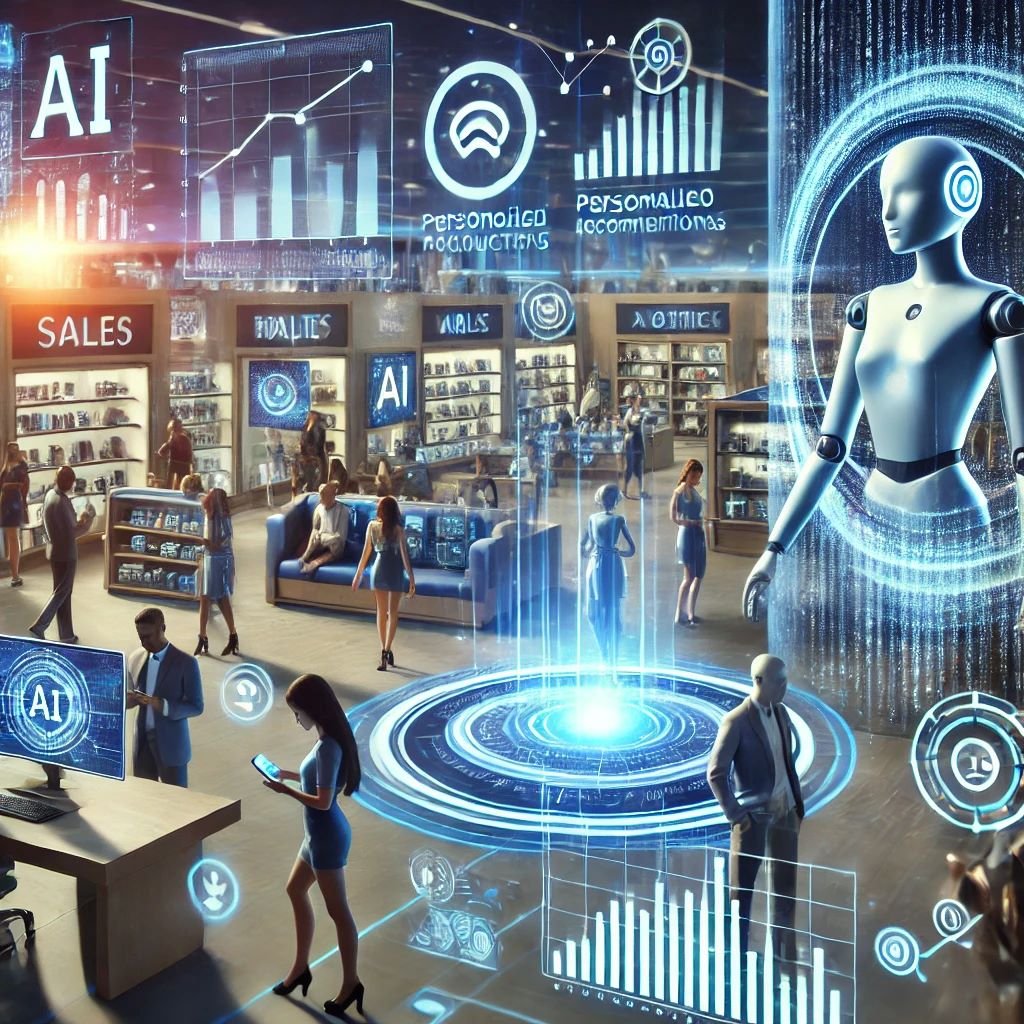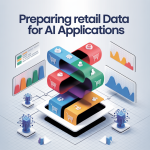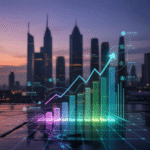
Tailoring Retail Marketing Campaigns Using AI Insights
Artificial intelligence (AI) has revolutionized retail marketing by enabling businesses to create hyper-personalized campaigns that resonate with their target audience.
By analyzing customer data, predicting behaviors, and automating processes, AI provides actionable insights that maximize the impact of marketing efforts.
Here’s how AI is empowering retailers to craft tailored marketing campaigns.
1. The Role of AI in Retail Marketing
AI leverages advanced algorithms to analyze vast amounts of data, identify patterns, and predict customer behavior.
This allows retailers to design campaigns that are personalized, timely, and effective.
Key Functions of AI in Marketing:
- Customer Segmentation: Groups customers based on preferences, behaviors, and demographics.
- Predictive Analytics: Anticipates future trends and customer actions.
- Campaign Automation: Schedules and optimizes marketing activities across channels.
Example: An online retailer uses AI to recommend products and craft email campaigns based on browsing history.
2. Applications of AI for Tailored Marketing Campaigns
A. Personalized Product Recommendations
AI analyzes purchase history, browsing patterns, and preferences to suggest products tailored to individual customers.
- Example: E-commerce platforms display “You May Also Like” sections personalized for each visitor.
B. Dynamic Content Creation
AI generates personalized marketing content, such as ads, emails, and social media posts.
- Benefits:
- Customizes headlines, images, and offers based on customer profiles.
- Increases engagement and click-through rates.
Example: Netflix uses AI to tailor movie recommendations and promotional emails based on viewing habits.
C. Predictive Targeting
AI identifies the best audience segments for specific campaigns by predicting which customers are most likely to engage.
- Impact: Ensures marketing budgets are spent on high-value prospects.
D. Real-Time Marketing
AI enables marketers to deliver personalized messages at the right moment.
- Examples:
- Sending abandoned cart reminders.
- Offering location-based promotions via mobile apps.
E. Customer Sentiment Analysis
AI monitors online reviews, social media mentions, and customer feedback to gauge sentiment and refine messaging.
- How It Helps:
- Identifies trends in customer emotions and preferences.
- Adjusts campaigns to address customer concerns or capitalize on positive sentiment.
3. Benefits of AI in Retail Marketing Campaigns
A. Enhanced Personalization
AI ensures every customer interaction feels tailored, improving engagement and loyalty.
B. Improved ROI
By targeting the right audience with the right message, AI-driven campaigns achieve higher conversion rates and cost-efficiency.
C. Increased Efficiency
AI automates repetitive tasks, such as data analysis and content scheduling, freeing up time for strategic planning.
D. Data-Driven Decisions
AI provides insights backed by data, reducing guesswork in campaign planning.
4. Tools and Technologies for AI-Driven Marketing
A. Predictive Analytics Platforms
- Examples: Google Analytics, Adobe Analytics.
- Use Case: Forecasting customer demand and campaign performance.
B. AI-Powered Email Marketing Tools
- Examples: Mailchimp, Klaviyo.
- Use Case: Crafting personalized email campaigns based on customer behavior.
C. Chatbots and Virtual Assistants
- Examples: ChatGPT, Zendesk.
- Use Case: Providing instant customer support and upselling products during interactions.
D. Social Media Analytics Tools
- Examples: Sprout Social, Hootsuite Insights.
- Use Case: Monitoring trends and crafting social media strategies.
5. Challenges and Solutions in AI-Driven Marketing
A. Data Privacy Concerns
Customers are wary of how their data is used.
Solution: Adhere to regulations like GDPR and CCPA, and ensure transparency in data usage.
B. Over-Personalization
Excessive personalization can feel intrusive to customers.
Solution: Balance personalization with privacy and avoid overstepping boundaries.
C. Integration with Existing Systems
Incorporating AI tools into legacy systems can be complex.
Solution: Use APIs and scalable platforms for seamless integration.
6. Future Trends in AI-Driven Marketing Campaigns
A. Voice-Activated Marketing
AI will create campaigns optimized for voice search and interactions with virtual assistants like Alexa and Google Assistant.
B. Hyper-Personalization
AI will deliver marketing messages based on real-time contextual data, such as location, weather, and immediate needs.
C. Augmented Reality (AR) Marketing
AI and AR will combine to create interactive campaigns, such as virtual try-ons or immersive product demos.
D. Emotional AI
AI will analyze customer emotions to tailor messaging that resonates on a deeper level.
AI empowers retailers to design marketing campaigns that connect with customers on a personal level, driving engagement, loyalty, and revenue.
By leveraging insights from data, predictive analytics, and automation, businesses can stay ahead of market trends and deliver impactful, cost-effective campaigns.
For retailers, adopting AI-driven marketing strategies is no longer a choice but a necessity in today’s competitive landscape.
ChatGPT in Retail Sales Forecasting: Enhancing Accuracy and Efficiency
Accurate sales forecasting is vital for the retail industry, impacting inventory management, staffing, and strategic planning.
ChatGPT, powered by AI, offers a dynamic approach to sales forecasting by analyzing historical data, identifying patterns, and providing actionable insights in a conversational and accessible format.
Here’s how ChatGPT is transforming retail sales forecasting.
1. The Role of ChatGPT in Sales Forecasting
ChatGPT excels at processing and interpreting vast datasets, turning complex insights into easy-to-understand predictions. Retailers can interact with ChatGPT to:
- Ask questions about sales trends.
- Explore “what-if” scenarios.
- Receive tailored recommendations for demand planning.
Example: A retailer asks ChatGPT, “What are the predicted sales for winter coats next month?” ChatGPT responds with forecasts based on historical sales, current trends, and weather data.
2. How ChatGPT Improves Retail Sales Forecasting
A. Enhanced Data Analysis
ChatGPT processes historical sales data, market trends, customer behavior, and external factors (e.g., holidays, weather) to deliver precise forecasts.
- Impact: Retailers gain a holistic view of sales drivers and potential challenges.
B. Interactive Forecasting
Unlike static reporting tools, ChatGPT allows retailers to ask specific questions and refine forecasts in real time.
- Benefit: Increases understanding and usability of forecasting data.
C. Integration with Existing Systems
ChatGPT can integrate with POS systems, inventory management platforms, and CRM tools to provide unified insights.
- Example: “How will our Black Friday promotions impact December inventory needs?”
D. Real-Time Updates
ChatGPT incorporates real-time data, allowing forecasts to adapt quickly to changing circumstances, such as market disruptions or unexpected demand surges.
- Impact: Enables agile decision-making in fast-paced retail environments.
3. Applications of ChatGPT in Retail Sales Forecasting
A. Seasonal Demand Planning
ChatGPT predicts sales fluctuations during peak seasons and holidays.
- Example: A toy retailer uses ChatGPT to forecast holiday demand for popular products, avoiding stockouts or overstocking.
B. Product Launch Forecasting
Predicts the success of new product launches by analyzing similar past launches and market conditions.
- Example: “How will introducing a vegan snack line affect overall grocery sales next quarter?”
C. Regional and Store-Level Forecasting
ChatGPT generates location-specific forecasts, helping retailers tailor strategies for individual stores.
- Example: ChatGPT can identify higher demand for snow gear in colder regions while suggesting summer inventory for warmer climates.
D. Marketing Impact Analysis
Evaluates how promotions, discounts, or ad campaigns influence future sales.
- Example: “What are the projected sales increases for our 20% off summer sale?”
4. Benefits of Using ChatGPT for Sales Forecasting
A. Increased Forecast Accuracy
By analyzing multiple data points, ChatGPT provides precise predictions, reducing the risk of overstocking or stockouts.
B. Accessibility and Usability
ChatGPT’s conversational interface makes complex forecasting data accessible to all team members, not just data analysts.
C. Cost and Time Efficiency
Automates forecasting tasks, freeing up staff to focus on strategic activities.
D. Improved Decision-Making
ChatGPT offers clear, actionable insights that empower retail managers to make informed decisions.
5. Challenges and Solutions
A. Data Quality and Integration
Inaccurate or incomplete data can compromise forecasts.
Solution: Implement robust data collection practices and ensure seamless integration of ChatGPT with existing systems.
B. Resistance to AI Adoption
Staff may be hesitant to rely on AI tools.
Solution: Provide training and demonstrate how ChatGPT enhances, rather than replaces, human expertise.
C. Over-Reliance on Predictions
Blindly trusting AI without considering external factors can lead to errors.
Solution: Use ChatGPT as a decision-support tool alongside human judgment.
6. The Future of ChatGPT in Retail Sales Forecasting
A. Hyper-Localization
ChatGPT will offer hyper-localized forecasts based on micro-trends and real-time data for specific neighborhoods or stores.
B. Scenario Simulations
Retailers will use ChatGPT to simulate various scenarios, such as “What if we extend store hours during the holiday season?”
C. Integration with IoT Devices
ChatGPT will analyze data from smart shelves and sensors to refine sales predictions further.
D. Predictive Collaboration
ChatGPT will facilitate cross-departmental collaboration by generating unified forecasts that align inventory, marketing, and staffing plans.
ChatGPT is revolutionizing retail sales forecasting by making it more interactive, precise, and actionable.
By harnessing its capabilities, retailers can better anticipate customer demand, optimize inventory, and enhance decision-making.
Embracing ChatGPT as a forecasting tool ensures a competitive edge in today’s data-driven retail landscape.
Enhancing Online and In-Store Customer Journeys with AI
The customer journey, both online and in-store, is at the heart of the retail experience.
By leveraging AI, retailers can create seamless, personalized, and efficient experiences that cater to customer preferences and behaviors.
From browsing to post-purchase engagement, AI enhances every stage of the journey, boosting satisfaction and loyalty.
1. The Role of AI in Enhancing Customer Journeys
AI provides retailers with tools to analyze customer behavior, predict needs, and deliver personalized interactions.
- Online: AI optimizes website navigation, recommends products, and enables real-time assistance.
- In-Store: AI supports staff, automates processes, and creates immersive shopping experiences.
Example: An AI-powered chatbot on an e-commerce site answers questions instantly, while an in-store kiosk guides customers to the right aisle.
2. Enhancing the Online Customer Journey
A. Personalized Product Recommendations
AI analyzes browsing history, purchase behavior, and preferences to suggest relevant products.
- Example: Amazon’s “Customers who bought this also bought” section boosts cross-selling opportunities.
B. Streamlined Navigation
AI ensures customers find what they need quickly through intelligent search and filtering.
- Feature: Natural Language Processing (NLP) lets users type questions like, “What’s the best smartphone under $500?”
C. Virtual Assistants and Chatbots
ChatGPT-like bots offer real-time assistance for product inquiries, order tracking, and troubleshooting.
- Benefit: Reduces cart abandonment and improves customer support.
D. Dynamic Pricing and Promotions
AI adjusts prices and offers based on demand, browsing behavior, and competitor analysis.
- Example: Flash sales targeting customers who frequently browse but haven’t purchased.
E. Post-Purchase Engagement
AI automates follow-up emails, solicits feedback, and recommends complementary products.
- Impact: Builds loyalty and encourages repeat purchases.
3. Enhancing the In-Store Customer Journey
A. Smart Navigation
AI-powered kiosks or mobile apps guide customers to products, saving time and improving convenience.
- Example: A grocery store app that maps the quickest route to items on a shopping list.
B. Virtual Try-Ons and AR Experiences
AI combined with augmented reality (AR) allows customers to visualize products before buying.
- Example: Clothing stores offering virtual fitting rooms.
C. Personalized Assistance
AI equips store associates with real-time data on customer preferences and purchase history.
- Benefit: Enables tailored recommendations and better service.
D. Inventory Transparency
AI ensures customers have accurate, real-time information about stock availability.
- Feature: Displays in-stock locations for products across nearby stores.
E. Self-Checkout and Automation
AI streamlines checkout processes with cashier-less systems or mobile payment apps.
- Example: Amazon Go stores let customers grab items and leave, with AI handling payments.
4. Integrating Online and In-Store Experiences
Seamless integration of online and in-store journeys ensures a cohesive customer experience.
A. Click-and-Collect Services
AI predicts optimal store pickup times based on customer schedules.
- Impact: Enhances convenience for online shoppers who prefer in-store pickups.
B. Omnichannel Loyalty Programs
AI personalizes rewards across online and offline channels, encouraging consistent engagement.
C. Cross-Channel Recommendations
Online browsing history informs in-store suggestions, and vice versa.
- Example: A customer browsing skincare online gets personalized recommendations in-store via an app.
D. Real-Time Inventory Syncing
AI ensures customers can see accurate stock availability across online and physical locations.
5. Benefits of AI-Enhanced Customer Journeys
A. Improved Personalization
AI tailors the experience to each customer, making them feel valued and understood.
B. Increased Engagement
Interactive tools like chatbots and AR keep customers engaged throughout their journey.
C. Higher Conversion Rates
AI reduces friction points, such as difficulty finding products or long checkout times.
D. Better Data Insights
AI gathers valuable data on customer behavior, helping retailers refine strategies.
6. Challenges and Solutions
A. Data Privacy Concerns
Customers may hesitate to share personal data.
Solution: Be transparent about data usage and adhere to privacy regulations.
B. Balancing Automation and Human Touch
Over-automation can feel impersonal.
Solution: Use AI to complement, not replace, human interactions.
C. Integration Complexities
Connecting online and in-store systems can be challenging.
Solution: Invest in scalable, unified platforms that support omnichannel operations.
7. Future Trends in AI for Customer Journeys
A. Emotion AI
AI will analyze customer emotions through voice or facial recognition to tailor interactions further.
B. Voice Commerce
Voice assistants will simplify online shopping with conversational ordering.
C. Predictive Personalization
AI will anticipate customer needs before they express them, offering proactive solutions.
D. Fully Immersive AR/VR Stores
Virtual stores will replicate the in-store experience for online shoppers.
AI is redefining the customer journey, seamlessly blending online and in-store experiences to create personalized, efficient, and engaging interactions.
By adopting AI-powered tools, retailers can stay ahead of evolving customer expectations, building loyalty and driving growth in an increasingly competitive market.


